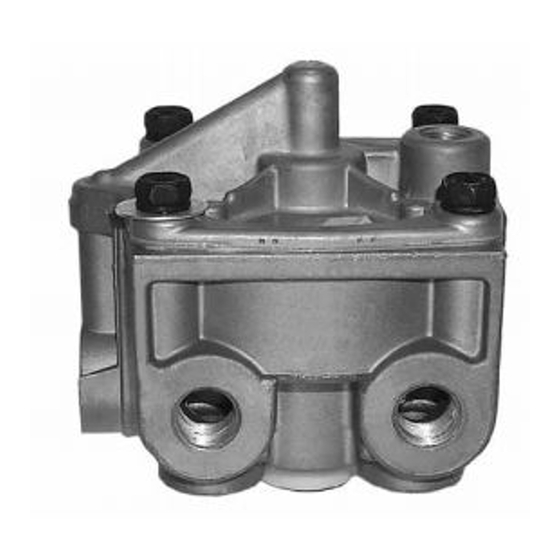BENDIX R-12P PILOT RELAY VALVE Manual - Page 5
Browse online or download pdf Manual for Control Unit BENDIX R-12P PILOT RELAY VALVE. BENDIX R-12P PILOT RELAY VALVE 8 pages. Pilot relay valve

If, during the light brake application, the driver modulates
the treadle slowly, and not enough to open the R-12P
valve, the desired control pressure will still pass on to the
next valve, maintaining zero differential.
EQUALIZING (SLOW) EXHAUST (SEE FIGURE 8)
As described earlier, the result of any service brake
application with an R-12P
above and below the relay piston. If the brake valve is
modulated slowly upon release so that pressure beneath
the piston is not great enough to open the exhaust, delivery
air will pass through the equalizing orifi ce and out the
control port to be exhausted.
REDUCTION OF SUPPLY PRESSURE
Figure 9 shows the R-12P
With no supply air, the reserve spring is strong enough to
hold the relay piston on the exhaust seat, but it is not strong
enough to overcome the force of the inlet/exhaust valve
spring. So both inlet and exhaust valves are closed.
Service Brake Applications with Reduced Supply
Pressure
Rapid Application - Use of Supply Line Single Check
Valve
If a rapid service brake application is made, control air moves
the relay piston and opens the inlet valve; but there is no
supply air to deliver. Control air then travels into the supply
port. The single check valve in the R-12P
port (shown in Figure 2) prevents this air from escaping to
atmosphere through the open or damaged supply source.
Control air also passes through the equalizing orifi ce and
out the delivery port, assuring no reduction or loss of control
signal to subsequent vehicles.
Equalizing (Slow) Application
If an equalizing (slow) service brake application is made
with reduced supply air pressure, control air passes
through the equalizing orifi ce and out the delivery port to
subsequent vehicles in the train.
Control air cannot escape to atmosphere because the
reserve spring keeps the exhaust closed.
™
valve is air pressure balance
™
valve with no supply pressure.
™
valve supply
™
inlet
LOAD PISTON
RELAY PISTON
SUPPLY PORT
INLET/EXHAUST
VALVE
FIGURE 9 - REDUCTION OF SUPPLY PRESSURE
WARNING! PLEASE READ AND FOLLOW
THESE INSTRUCTIONS TO AVOID PERSONAL
INJURY OR DEATH:
When working on or around a vehicle, the following
general precautions should be observed at all times.
1. Park the vehicle on a level surface, apply the
parking brakes, and always block the wheels.
Always wear safety glasses.
2. Stop the engine and remove ignition key when
working under or around the vehicle. When
working in the engine compartment, the engine
should be shut off and the ignition key should be
removed. Where circumstances require that the
engine be in operation, EXTREME CAUTION should
be used to prevent personal injury resulting from
contact with moving, rotating, leaking, heated or
electrically charged components.
3. Do not attempt to install, remove, disassemble
or assemble a component until you have read
and thoroughly understand the recommended
procedures. Use only the proper tools and observe
all precautions pertaining to use of those tools.
4. If the work is being performed on the vehicle's
air brake system, or any auxiliary pressurized air
systems, make certain to drain the air pressure
from all reservoirs before beginning ANY work
on the vehicle. If the vehicle is equipped with an
®
AD-IS
air dryer system or a dryer reservoir module,
be sure to drain the purge reservoir.
RESERVE SPRING
SEALS EXHAUST
CONTROL
PORT
DELIVERY PORT
5
